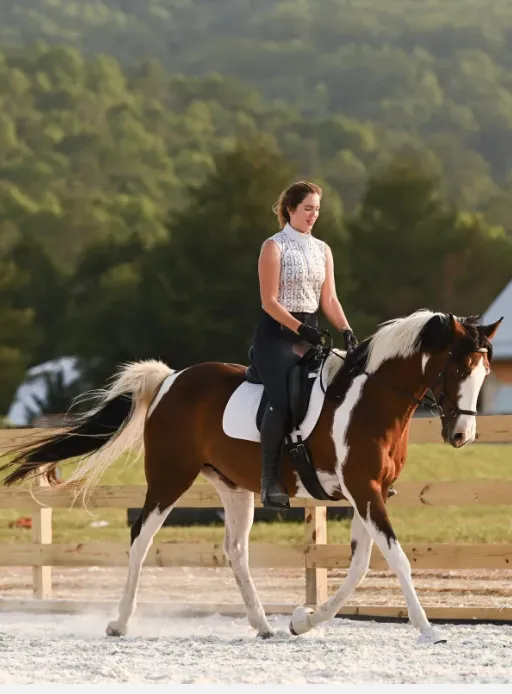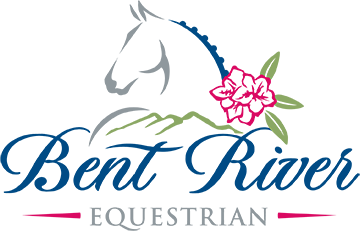
Americans and Dressage, are they oil and water?
Dressage is not a well understood discipline by the majority of riders in America. In the past, Americans learned to ride in a forward seat, so we were ready to go foxhunt and socialize with our peers. Hunt Seat classes in the arena helped encourage more formalized and stylized riding for young riders so that they would be able to safely participate in social events. Do you remember the scene in Gone With The Wind, where Scarlett’s daughter Bonnie dies from her horse refusing a fence? Not what any father who could afford for his child to take lessons would want!
In the present day, there are more members in USHJA (44,000+) versus USDF (30,000+), showing that it has a stronger hold in equestrian sport, although thankfully Dressage numbers are growing. I participated in a typical Hunter/Jumper program after school with Saturday shows, moving up to being able to jump higher and faster once my eye for distances was trained. It was when my toes dipped into eventing that we found the challenge and joy of Dressage.
The current interconnectedness of the world should make training horses for Dressage more fun, providing riders and trainers with more knowledge, techniques, and evidence that supports horse welfare in sport. However, the best Dressage educators typically write print books.
Unfortunately, these days it can be really disheartening to have “trainer” as a title, when many greats suffer falls from grace thanks to Facebook. Thankfully, there are amazing amazing women steering conversations regarding sport and equine welfare for objective thinkers like you and me to ponder. Next time you’re cleaning a stall, be sure to listen to Dear Horse World, Horse People, or Dressage Naturally with Karen Rolf to hear from professionals who love their jobs and their sports.
Dressage sport goes back to Europe, as does hunting and all equestrian sports. Although some armies developed systems of training in the forward seat (Italy, Russia), for example, the higher schools throughout Germany, France, Austria, and Portugal have developed cavalry systems that ended up producing horses in an upright and collected balance. Evolving from needs of the battleground to pure Art, Harmony, and Connection, Dressage as a discipline today still is an athletic endeavor with strong elements of trust and relationship building.
The true masters from history, however, lived like artists, sponsored by royalty to pursue training horses to the highest form with little stress from the mundane. This concept is a little out of reach for most Americans, and most American trainers are forced to attempt to become successful at business while mastering their craft.
Americans rejecting the monarchy is not the only reason our culture does not enmesh easily with Dressage. Americans never needed highly schooled horses for war - the colonizers did not have to go to battle against other horsemen, until the indigenous people learned to ride. Even then, American horses developed for the purpose of working cows and maintaining ranches, and form has followed function.
Because Dressage techniques come from many different countries and schools, and are closely intertwined with royal funding, Americans feel distant to the sport. This is compounded by the American Quarter Horse and American Racehorse being prevalent breeds in lessons programs across the country. I have nothing negative to say about these breeds, and they actually bring a fast metabolism which brings certain strengths to the sport arena and bloodlines. The jumpers know it, but as we mentioned, royal and European influence on Dressage impedes it.
Most Americans in the English disciplines are taught to ride in their half seat and two points to stay in balance and to jump securely, so they do not end up like Little Bonnie. That being said, most Americans are not often introduced to helping their horse be better on the bit or hind legs in ways that really support their understanding and growth as riders. It is up to well studied and skilled trainers to help their horse feel what they need to feel in order to succeed.
When horses are shown how to utilize their bodies for Dressage, they gain confidence and willingness. Dressage training supports horses in becoming more coordinated, developing a back to front balance that supports their rider and minimizes tripping and other hazards. It develops an attentiveness that reduces the spookiness and reactivity. When horses are maintaining the purity of their gait and thinking back to front, it allows them to stay closer to the parasympathetic nervous system, which is something we all strive for in our rides.
Dressage training focuses on flexibility and straightness. Good training helps horses find equal strength and suppleness in both directions, so that the aids are accepted easily and consistently. This also relates to the lower end of the training scale, Losgelassenheit in German.
Dressage training supports a feeling of joy and trust in the horse, thanks to them staying nearer the Parasympathetic nervous system. Horses perform well for trainers who know how to help them perform.
When you're training and even showing a horse, every moment can not be perfect, but for the trainers whose horses look to the rider in each second, while holding softness and connection across their backs, there is an unmatched pleasure to watch. All resulting from war and then further developed by artists who were commissioned by royalty.

